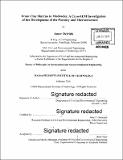From clay slurries to mudrocks : a cryo-SEM investigation of the development of the porosity and microstructure
Author(s)
Deirieh, Amer (Amer Mohammad)
DownloadFull printable version (26.19Mb)
Other Contributors
Massachusetts Institute of Technology. Department of Civil and Environmental Engineering.
Advisor
John T. Germaine.
Terms of use
Metadata
Show full item recordAbstract
This thesis investigates the microstructure of smectitic and illitic rich mudrocks that are resedimented in the laboratory from the Gulf of Mexico and Boston Blue clay natural sediments. The resedimentation technique consists of mixing clay sediments with saline water to form a slurry, which is then subjected to a wide range of effective stresses. Cryo-SEM and conventional SEM techniques are used to investigate the microstructure of the clay slurry and resedimented mudrocks. Cryo-SEM enables the imaging of samples in their in-situ conditions, while conventional SEM is used to image oven-dried samples. Two techniques are used to prepare the slurry samples for cryo-SEM imaging: high-pressure freezing and plunge freezing. The microstructure of high-pressure frozen clay slurries consists of individual clay particles and clay aggregates randomly distributed in water. These results demonstrate that one of the widely accepted models for clay slurries, the honeycomb structure, is an artifact of the plunge-freezing method and does not reflect the in-situ structure. In the field of geological sciences, this contrasts a fundamental view of fabric evolution that has inferred the presence of honeycomb structures that gradually evolve to an oriented fabric. Furthermore, we developed a method to obtain representative information about the heterogeneous pore space of mudrocks. This method combines information obtained from SEM images at different magnifications to represent the porosity of mudrocks. High magnification images provide high resolution and are used to sample small pores, while low magnification images provide low resolution and are used to sample large pores. The developed method provides a practical alternative to the current method that stitches together hundreds of images to obtain large representative mosaics. We show that SEM imaging detects only a fraction (~30%) of the total porosity of mudrocks, neglecting the significant amount of pores below the resolution of SEM. Furthermore, we show that oven drying, which is a prerequisite for most characterization methods, leads to a dramatic shrinkage (~50%) in the nanometer-sized clay pores, and does not influence the pore space visible in SEM images. Finally, we show that the application of stress on mudrocks leads to a simultaneous compression of inter-particle and intra-particle pores.
Description
Thesis: Ph. D. in Geotechnical and Geoenvironmental Engineering, Massachusetts Institute of Technology, Department of Civil and Environmental Engineering, 2016. Cataloged from PDF version of thesis. Includes bibliographical references (pages 218-226).
Date issued
2016Department
Massachusetts Institute of Technology. Department of Civil and Environmental EngineeringPublisher
Massachusetts Institute of Technology
Keywords
Civil and Environmental Engineering.